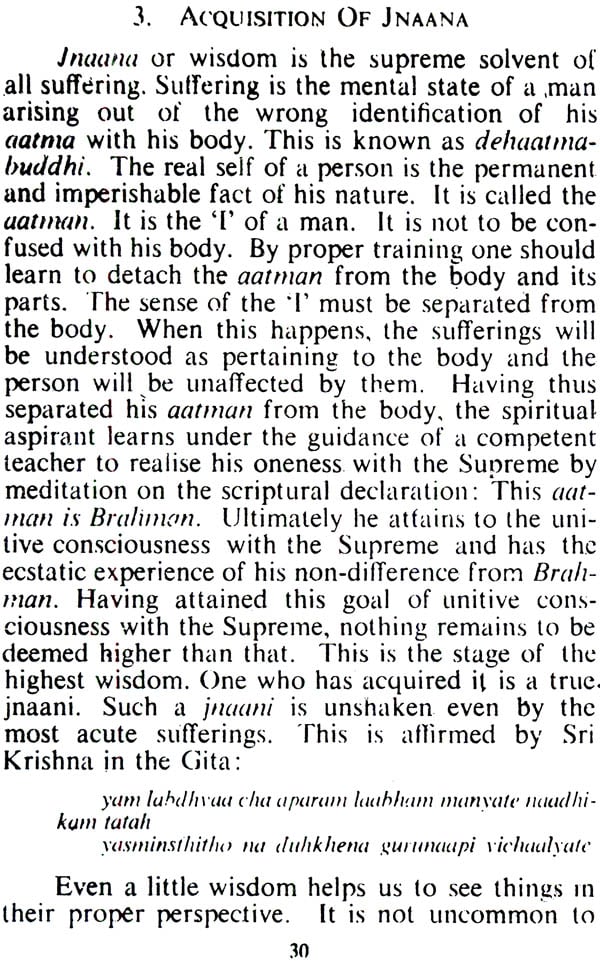
Aspects Of Our Religion
Book Specification
| Item Code: | NAE491 |
| Author: | Sri Chandrasekharendra Saraswati |
| Publisher: | Bharatiya Vidya Bhavan |
| Language: | English |
| Edition: | 1997 |
| Pages: | 73 |
| Cover: | Paperback |
| Other Details | 7.5 inch X 5.0 inch |
| Weight | 80 gm |
Book Description
His Holiness Jagadguru Sri Chandrasekaharendra Saraswati is the Sankaracharya who adorns the Kanchi Kamakoti Pitha in Tamil nadu. His Holiness is the 68th in the succession of the occupants of the Pitha. He is devoutly adored hy his disciples and held in reverential esteem by numerous others for his scholarship in the saastras and knowledge of modern developments, for his saintliness and for his inclusive universality of outlook and attitude. His gracious eyes which beam a benediction and his inviting smile which casts a spell of intimacy leave an everlasting impression on all those who have had the good fortune to have a darshan of him.
An itinerant ascetic that he is, traversing the country on foot. His holiness holds large audiences in thrall by the discourses that he delivers in Tamil in such sweet simple words which are the despair of the pedant and the delight of the innocent. His expositions of Hindu religion, some of which are reproduced here, have a classical fidelity which one misses in modern ‘liberal’ treatments. The reader will be amply rewarded by a careful study of its contents which show the rasion deter of many doctrines and tenets of Hindu religion not generally understood in their proper import.
The Bharatiya Vidya Bhavan – that institute of Indian Culture in Bombay – needed a Book University, a series of books which, if read would serve the purpose of providing higher education. Particular emphasis, however was to be put on such literature as revealed the deeper impulsions of India. As a first step, it was decided to bring out in English 100 books, 50 of which were to be taken in hand almost at once. Each book was to contain from 200 to 250 pages.
It is our intension to publish the books we select, not only in English, but also in the following Indian languages: Hindi, Bengali, Gujarati, Marathi, Tamil, Kannada and Malayalam.
This scheme, involving the publication of 900 volumes, requires ample funds and an all- India organization. The Bhavan is exerting its utmost to supply them.
The objectives for which the Bhavan stands are the reintegration of Indian culture in the light of modern knowledge and to suit our present-day needs and the resuscitation of its fundamental values in their pristine vigour.
Let me make our goal more explicit:
We seek the dignity of man, which necessarily implies the creation of social conditions which would allow him freedom to evolve along the lines of his own temperament and capacities, we seek the harmony of individual efforts and social relations not in any makeshift way, but within the frame-work of the Moral Order; we seek the creative art of life, by the alchemy of which human limitations are progressively transmuted, so that man may become the instrument of God, and is able to see Him an all and all in Him.
The world, we feel, is too much with us. Nothing would uplift or inspire us so much as the beauty and aspiration which such books can teach. In this series, therefore, the literature of India, ancient and modern, will be published in a form easily accessible to all. Books in other literatures of the world, if they illustrate the principles we stand for, will also be included.
This common pool of literature, it is hoped, will enable the reader, eastern or western, to understand and appreciate currents of world thought, as also the movements of the mind in India, which, though they flow through different linguistic channels, have a common urge and aspiration.
Fittingly, the Book University’s first venture is the Mahabharata, summarised by one of the greatest living Indians, C. Rajagopalachari; the second work is on a section of it, the Gita by H. V. Divatia, an eminent jurist and a student of philosophy. Centuries ago, it was proclaimed of the Mahabharata: “What is not in it, is nowhere.” After ‘twenty-five centuries, we can use the same words about it. He who knows it not, knows not the heights and depths of the soul; he misses the trials and tragedy and the beauty and grandeur of life.
The Mahabharata is not a mere epic; it is a romance, telling the tale of heroic men and women and of some who were divine; it is a whole literature in itself, containing a code of. life; a philosophy of social and ethical relations, and speculative thought on human problems that is hard to rival; but, above all, it has for its core the Gita, which is, as the world is beginning to find out, the noblest of scriptures and the grandest of sagas in which the climax is reached in the wondrous Apocalypse in the Eleventh Canto.
Through such books alone the harmonies um derlying true culture, I am convinced, will one day reconcile the disorders of modem life.
I thank all those who have helped to make this new branch of the Bhavan’s activity successful.
| I | Our Religion | 1 |
| II | Ours - A Universal Religion | 7 |
| III | "Age" Of The Vedas | 10 |
| IV | Contents Of The Vedas | 14 |
| V | The Spiritual Path | 17 |
| VI | The Gita Way | 33 |
| VII | The Strength Of Our Religion | 41 |
| VIII | Some Of Our Religious Institutions | 48 |
| IX | Moorti Pooja Or Image Worship | 57 |
| X | The Currency Of Dharma | 66 |
| XI | Secret Of Happiness | 70 |






